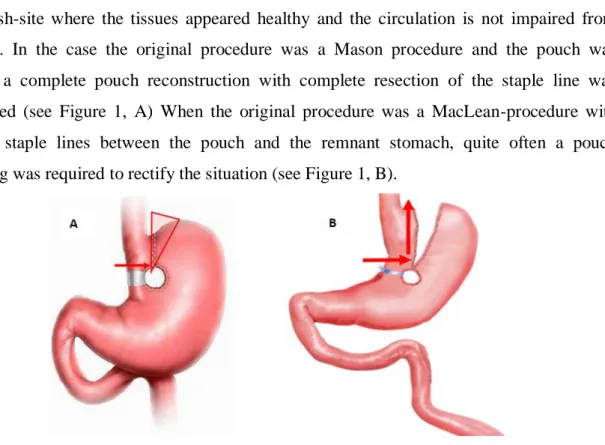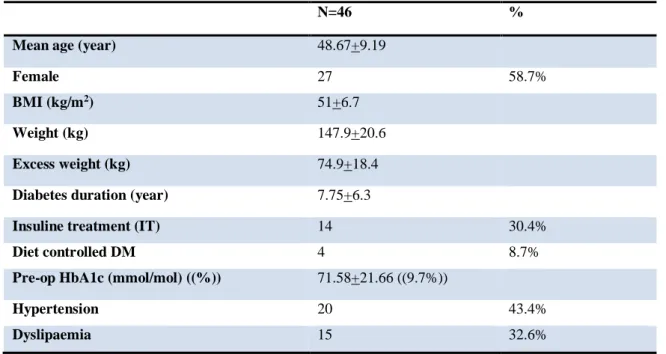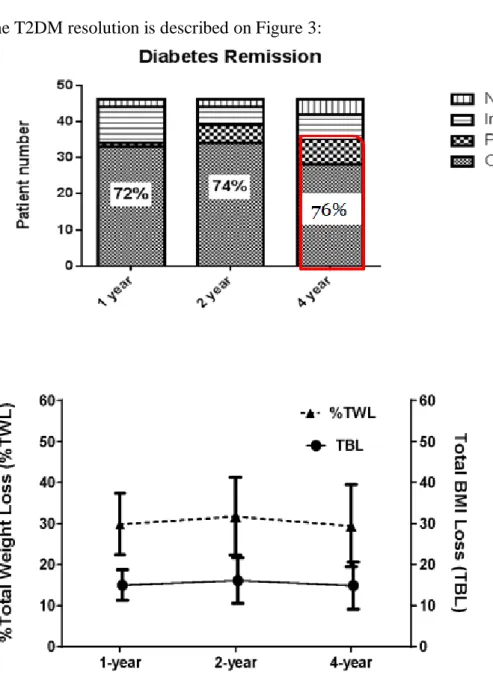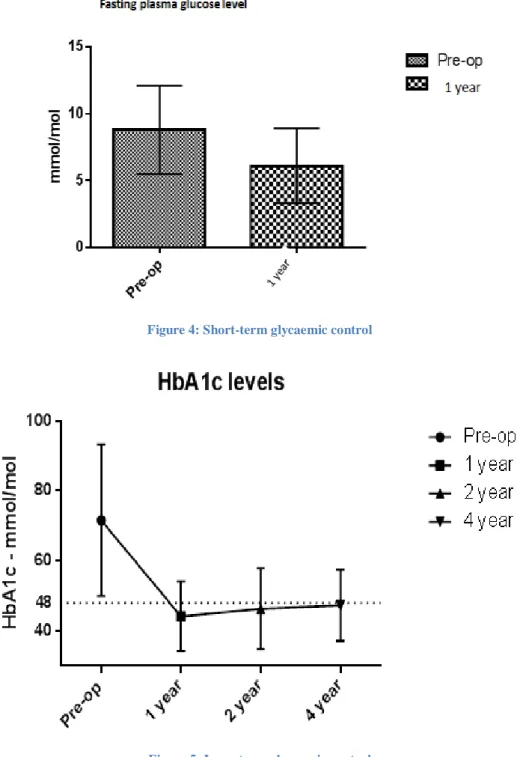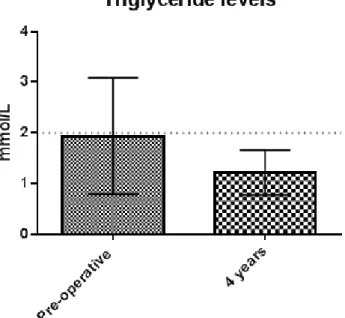Assessment of the Roux-en-Y gastric bypass as a primary and secondary bariatric procedure and its effect
on type 2 diabetes mellitus
Ph. D. Theses
Péter Vasas M.D.
Semmelweis University
Doctoral School of Clinical Medicine
Tutor: László Harsányi, Ph.D, professor
Opponents: Nóra Hosszúfalusi, Ph.D,
András Bálint, Ph.D.
Board of final examination:
László Kóbori, Ph.D, professor Elemer Mohos, Ph.D.
Márk Juhász, Ph.D.
Budapest 2015
1 1. Introduction
The wars in the 18th and 19th century brought starving and famine for millions. The industrialisation and the advanced technologies in the agricultural industry provided access to quality foods for most of the people. However, the malnourishment is still present at certain parts of the World, a significant number of people absorbs more calories than needed daily.
The authorities view that obesity is one of the most serious public health problems of the 20th century. Hungary is amongst the mostly affected countries in Europe, as 25% of the adult population is obese.
Obesity initially causes the accumulation of the subcutaneous fatty tissue, and cause daily problems in life quality on an individual basis. As obesity progresses, it causes numerous co- morbidities, such as cardio-vascular disease, type 2 diabetes mellitus (T2DM), obstructive sleep apnoea syndrome, hypercholesterolemia and subsequent atherosclerosis, musculoskeletal diseases, depression and social isolation. Furthermore, the fertility decreases and there is increased predisposition for malignant diseases, secondary to hormonal and metabolic changes.
It became obvious that morbid obesity reduces the life expectancy significantly, as a 25-year- old male’s life could be 12 years shorter that his normal weight counterpart.
The World Health Organisation drew a frightening picture about the rate of morbid obesity, and described the increasing prevalence of subsequent diabetes as a pandemic. According to their prediction – assuming that T2DM spreads with the current rate – the medical systems might collapse due to the financial shortage secondary to the astronomical expenses of T2DM and its complications.
The first line treatment of morbid obesity is the lifestyle modification, including dietary restriction and increased physical activities. However, in 95% of cases these yield a temporary result. The pharmaceutical companies spend huge amounts of money in developing the “magic pill”. Currently, bariatric surgery is the only valid option to achieve sustained weight loss and the T2DM remission.
2
2. Aims
The prevalence of morbid obesity exceeds all previous expectations and subsequently the diabetes incidence is also rapidly rising. Currently the bariatric (metabolic) surgery is the only valid option to achieve diabetes remission. The RYGB has a significant impact on weight loss and diabetes remission, however, the results are proven only on short term basis and the long-term evidence is sparse.
This thesis is divided into two parts and we separately assessed the effect of RYGB from surgical and metabolic aspect.
1. Assessment of the currently utilised minimally invasive techniques from the surgical aspect
1.1. The description of the primary operative technique, and the description and the comparison of the gastro-jejunostomy creation and assessment of the short- and long- term outcome.
There are different laparoscopic techniques to perform RYGB, comparison was made to assess the outcome in terms of safety, reliability and reproducibility.
Our aim was to compare the short- and long-term outcome of the linear-, circular- and hand-sewn gastro-jejunostomy formation. We examined the perioperative morbidity related to these techniques. We compared the safety profile of these operative techniques.
1.2. Description of conversion techniques and the analysis of the results We examined the following criteria:
Is the laparoscopic RYGB a valid option for conversion after failed primary bariatric procedure?
Does the associated safety profile differ from the primary RYGB?
Does the conversion RYGB restore the patients’ suboptimal life quality?
3 2. Assessment of the short- and long-term metabolic effect of RYGB, with special focus on
type 2 diabetes mellitus
The short-term effect of RYGB on T2DM is well-known nowadays.
We examined the effect of the operation on long-term diabetes remission and aimed to assess the outcome after 4 years. We aimed to identify the predictors of success for diabetes remission. And finally, we examined the effect of RYGB on further metabolic conditions.
3. Methods
3.1. The primary RYGB
Different surgical techniques have been developed to perform laparoscopic RYGB. These differ in the gastro-jejunostomy formation and the route of the alimentary Roux limb. The main techniques are the linear-, circular stapled and the hand-sewn gastro-jejunostomy formation. A detailed description of these techniques is described in this chapter.
We assessed the outcome of the bariatric procedures according to the following scheme:
1. Reduction in weight (reduction in %Excess Weight Loss, reduction in BMI or absolute weight)
2. The remission of the co-morbidities of morbid obesity 3. Life quality improvement (utilising the BAROS-score)
3.2. Conversion RYGB
RYGB is considered as the revisional procedure of choice. However, revisional bariatric surgery is associated with relatively higher rates of complications, such as bleeding and anastomotic leak. The vertical banded gastroplasty (VBG) used to be a popular restrictive bariatric procedure in the 1990s, but nowadays it is out from the bariatric surgeons’ repertoire due to its late complications (band erosion and stenosis).
In many VBG patients, this narrowing or sometimes kinking of the neo-pylorus caused a progressive gastric outlet obstruction with medically untreatable vomiting, dysphagia or reflux as a result.
4 Retrospective analysis of the prospectively collected data from the “A” institute was performed. All patients with a prior VBG who underwent a revisional bariatric procedure were identified; regardless whether the original operation was open (Mason) or laparoscopic (MacLean). We describe the operative technique in details.
The pouch formation:
The first step in the gastric pouch creation was to transect the stomach horizontally with a 60- mm-long thick linear stapler perpendicular to the lesser curve, well above the previous ring/mesh-site where the tissues appeared healthy and the circulation is not impaired from scarring. In the case the original procedure was a Mason procedure and the pouch was dilated, a complete pouch reconstruction with complete resection of the staple line was performed (see Figure 1, A) When the original procedure was a MacLean-procedure with divided staple lines between the pouch and the remnant stomach, quite often a pouch trimming was required to rectify the situation (see Figure 1, B).
Figure 1: RYGB pouch creation after VBG. A: Mason-type B: MacLean-type
3.3.The effect of RYGB on T2DM
We reviewed the effect of the operation on T2DM on short- and long-term.
A retrospective review of the departmental database was performed in November 2014, and all patients were reviewed who completed 4 years follow-up after bariatric surgery. All patients were included, who had Roux-en-Y gastric bypass and diabetes between Sep 2009 and Nov 2010. The primary end-point was the diabetes remission; following the ADA guidelines.
5
• Remission criteria were: (Remission=CR+PR)
▫ Complete (CR): HbA1c<48 mmol/mol (6.5%)+ no active antidiabetic meds
▫ Partial (PR): HbA1c: 48-53 mmol/mol (6.5-7%)+ no active antidiabetic meds We used the “Improved” category, when there was >50% reduction in medication or when the glycemic control was achieved after stopping insulin. Patients who did not fulfil these criteria were put into the “no change” category.
Our secondary end-point was the improvement of other obesity related metabolic co- morbidities.
4. Results
4.1.Comparison of the primary RYGB techniques
We compared the linear-, circular stapled and the hand-sewn technique, according to Table 1.
Short-term outcome
There were no significant differences amongst the techniques, in terms of safety. The perioperative morbidity was 4.74% in the “A” institute, and 5.43% and 7.34% in the “B” and
“C” institute, respectively. The rate of reoperation was below 2.5% in all cases, and most of these were due to postoperative bleeding. Both the “B” and the “C” institute had one leak, and the leak rate of “A” institute was 0.2%. The low numbers were not suitable to perform statistical analysis, but the leak rate was generally much lower than the generally reported 1- 2% rate.
Table 1: The reviewed patients
Technique Circular (A) Linear (B) Hand-sewn (C) p value
Cases 5 095 350 177
Duration (months) 85 24 24
Age 40.3+14.19 48+12 46+10 *** (A-B and A-C)
BMI (kg/m2) 41.87+7,12 50.5+8.49 53.8+7 *** (A-B and A-C)
Female ratio 76.2% 64.5% 71% NS
Co-morbidities
6
Hypertension 26.2% 40.8% 44% NS
T2DM 9.52% 49.7% 37% ** (A-B and A-C)
OSAS 3.85% 37.7% 25% *
Length of procedure (min)
59+15 105+21 116+28 *** (A-B and A-C)
Postop. morbidity 242 (4.74%) 19 (5.43%) 13 (7.34%) * (A-C)
Reoperation 74 (1.45%) 8 (2.28%) 3 (1.69%) NS
Mortality 1 0 0 N/A
Leak 8 (0.15%) 1 (0.28%) 1 (0.6%) N/A
Length of stay (day) 2.45+1.2 2.2+0,9 2.3+1.5 NS 6 months EWL% 45.08+20.31 47.24+19.65 54+14 * (A-C) 12 months EWL% 51.15+18.84 56.81+20 61.25+18.44 NS 24 months EWL% 59.3+15.21 63.81+23.59 64.09+20.75 NS
GJ stricture – N (%) 48 (0.95%) 3 (0.8%) 12 (6.8%) *** (A-C and B-C)
OS-MRS 0.62 2.81 2.78 ** (A-B and A-C)
BAROS score (2 yr) 3.8 + 0.59 6.7+1.12 6.02+1.58 ** (A-B and A-C)
*=p<0.05, **=<0.001, ***=p<0.001, NS= non-significant, N/A: non-applicable
Significant differences were found between the groups in the pre-op data, in terms of weight and co-morbidity rate. The “A” institute operated lighter patients, who had much lower co- morbidity rate.
We found significant difference in the gastro-jejunostomy stricture rate. The circular and the linear stapled anastomosis creation resulted in <1% stricture rate, but after the hand-sewn technique 6% of the patients required endoscopic balloon dilatation.
Long-term results
Significant weight loss difference was found 6 months’ post-surgery between “A” and “C”
institute. This difference was not sustained and disappeared at 12 and 24 months. We think that the significant pre-op weight differences explain this finding.
We evaluated the life quality improvement after 24 months, when the weight loss and the co- morbidity resolution have finished. All three institutes’ BAROS score reached the “good”
category (cumulated score>3), the patients from “B” and the” C” institute resulted in “very good” (p<0.0001).
7 4.2.Results of conversion RYGB
In the “A” institute, 153 patients were identified who had previous VBG and required conversion to RYGB. The main indication for revisional surgery was insufficient weight loss±weight regain in 145 patients (94.8 %). Additionally, a substantial number of patients experienced one or more major GI symptoms, which was related to the developing gastric outlet obstruction.
Table 2: Symptoms of conversion patients
N= 153 %
Regular vomiting 72 47.1%
Reflux 56 36.6%
Dysphagia 39 25.4%
Short-term Follow-up
There were no conversions to open surgery in our series and no leaks were observed. The mortality rate was zero. The mean hospital stay was 4.3 (3–10) days.
Long-term weight loss
The initial VBG procedure resulted in a substantial weight loss with a decrease in mean BMI from 39.4 to 28.1 kg/m2 (lowest post-VBG weight). The mean BMI increased to 34.2 kg/m2 prior to the RYGB conversion (pre-RYGB). After a median follow-up of 48 (10–81) months, the mean BMI decreased to 28.8 kg/m2 (p<0.05). The BMI flow chart is shown on Figure 2.
8
Figure 2: BMI change after VBG to RYGB conversion
The life quality of the patients has improved significantly. The BAROS score was 5.2+1.3, which is significantly better result, then the score after primary procedures from the same institute. (3.8 + 0.59)
4.3.The effect of RYGB on diabetes remission
Fourty-six patients had been reviewed to assess the effect of RYGB on long-term diabetes remission. The median (IQR) follow up was 52 (50-57) months. The baseline data is described on the Table 3.
Table 3: Diabetic patients’ details
N=46 %
Mean age (year) 48.67+9.19
Female 27 58.7%
BMI (kg/m2) 51+6.7
Weight (kg) 147.9+20.6
Excess weight (kg) 74.9+18.4
Diabetes duration (year) 7.75+6.3
Insuline treatment (IT) 14 30.4%
Diet controlled DM 4 8.7%
Pre-op HbA1c (mmol/mol) ((%)) 71.58+21.66 ((9.7%))
Hypertension 20 43.4%
Dyslipaemia 15 32.6%
9 The T2DM resolution is described on Figure 3:
Figure 3: Diabetes remission (above) and weight loss (below) after RYGB
10 We found the following changes in the short- and long-term glycaemic control.
Figure 4: Short-term glycaemic control
Figure 5: Long-term glycaemic control
The secondary end point was to examine the other metabolic co-morbidities’ improvement after RYGB.
11 The preoperative hypertension rate is reduced from 43% to 26% postoperatively. Similarly, the rate of obstructive sleep apnoea has reduced from 54% to 13%, and the rate of hypertriglyceridemia from 32% to 0, respectively.
Figure 6: Triglyceride level
12
Conclusions
1. The Roux-en-Y gastric bypass is the gold standard of the bariatric procedures, and this usually yields 70% excess weight loss and dramatic improvement in glycaemic control.
2. No differences were found between either of linear-, circular stapled or hand-sewn gastro-jejunostomy formations; in terms of safety, reliability and reproducibility.
3. The baseline patient characteristic was different between the examined groups, but we show that with meticulous planning the high-risk patient can be operated safely.
4. The hand-sewn gastro-jejunostomy results in almost 6% stricture rate after primary RYGB, opposed to the 1% stricture rate of the linear- or circular technique.
5. The RYGB is an excellent method for the conversion of a failed previous bariatric procedure, as it yields excellent weight loss and co-morbidity resolution. On top of this, the patients experience significant improvement in quality of life.
6. The reviewed 153 VBG to RYGB conversion demonstrates that the perioperative morbidity is low (3.9%) and comparable with the primary RYGB procedures.
7. The diabetes remission rate was 73.9% one year after RYGB.
8. This increased to 85% at 2 years’ time.
9. Despite the unfavourable predictive factors the 4-year diabetes remission rate was 76% (marked with red on Figure 3).
10. The male gender, the longer diabetes duration and the insulin requirement were the negative predictors for T2DM remission.
11. On univariate and multivariate analysis, significant EWL (p = 0.0027) and lower BMI (p = 0.018) at 4-years were the only independent clinical predictors of medium-term T2DM outcome.
12. The other examined factors (fasting plasma glucose, age) were not significant predictors.
13 13. The preoperative hypertension rate is reduced from 43% to 26% postoperatively.
14. The preoperative triglyceride reduced from the level 1.94+1.15 mmol/L to 1.22+0.44 mmol/L (p<0.05)
15. The prevalence of the sleep apnoea syndrome reduced significantly after 4 years’
follow-up; from the preoperative rate of 54% to 13%.
16. The sustained weight loss is fundamental for long-term diabetes remission.
14
The author’s publication
The publications related with this thesis:
Vasas P, Pór F. (2014) Current surgical options for reducing body weight. Hungarian Medical Journal,155: 971-977.
Barreca M, Vasas P, Whitelaw D, Yue D, Jain V. (2013) Disappointing long-term result after laparoscopic adjustable gastric band insertion. Bariatric Surgical Practice and Patient Care,December 2013: 140-146.
Vasas P, Dillemans B, Van Cauwenberge S, De Visschere M, Vercauteren C. (2013) Short- and Long-Term Outcomes of Vertical Banded Gastroplasty Converted to Roux-en-Y Gastric Bypass. Obesity surgery,23: 241-248
Publications which are not related with this thesis:
Herrod P, Boghossian S, Vasas P, (2014): Multifocal necrotising fascitis: a rarer presentation of a rare disease; BMJ Case Rep. 2014 Nov 20; pii: bcr2014207089.
DOI: 10.1136/bcr-2014-207089
Vasas P, Wiggins T, Chaudry MA, Bryant C, Hughes F (2012) Emergency presentation of the gastric cancer; implication for prognosis and service planning.
World Journal of Emergency Surgery, 7:31., DOI: 10.1186/1749-7922-7-31
Chan S, McCullough J, Schizas A, Vasas P , Engledow A, Windsor A, Williams A, Cohen CR. (2012) Initial experience of treating anal fistula with the Surgisis anal fistula plug; Tech Coloproctol. 16(3):201-6. Epub 2012 Apr 18. DOI:
10.1007/s10151-012-0810-0
15 Yiasemidou M, Glassman D, Vasas P, Badiani S, Patel B: Faster simulated laparoscopic cholecystectomy with haptic feedback technology; Dovepress Open Access Surgery; DOI: http://dx.doi.org/10.2147/OAS.S25008
Raptis D, Vasas P, Skipworth J, Nakawungu R, Oberkofler C, Cohen CR, Windsor A (2011): Development and Evaluation of Web-based Software to Efficiently Run Enhanced Recovery Surgery; electronic Journal of Health Informatics; Vol 6(2): e19
Vasas P, Patel B (2011): The genetic background and clinical features of the
hereditary gastric cancer; Orvosi Hetilap, Jul 1; 152(28):1105-1109, DOI:10/1556/OH.2011.29160
Wiggins T, Chaudry MA, Vasas P, Bryant C, Hughes F (2011); Aorto-oesophageal fistula: an unusual complication of oesophageal biopsies; BMJ Case Reports, DOI:
10.1136/bcr.01.2011.3770
Vasas P, Mudan SS (2011): Congenital microgastria with limb defect combined with
megaduodenum: case report and review of literature; Indian Journal of Surgery: Volume 73, Issue 2 , 122-124. DOI: 10.1007/s12262-010-0185-2
Vasas P (2011): Gallstone in abdominal wall, Snapshot, British Journal of Surgery;
21 Mar 2011
Vasas P, Winslet MC, Yang SY (2009): The role of insulin-like growth factor (IGF) in the cell division processes and in malignancy; Orvosi Hetilap, 150(51):2308-12, DOI: 101556/OH.2009.28733
Vasas P, Gosling J, McCullough JA, Prete FP (2009): Intestinal strangulation and sub-acute bowel obstruction in direct inguinal hernia; Grand Rounds, DOI:
10.1102/1470-5206.2009.006
